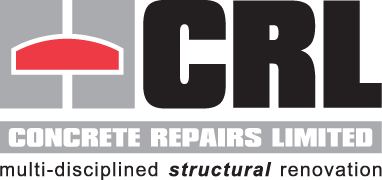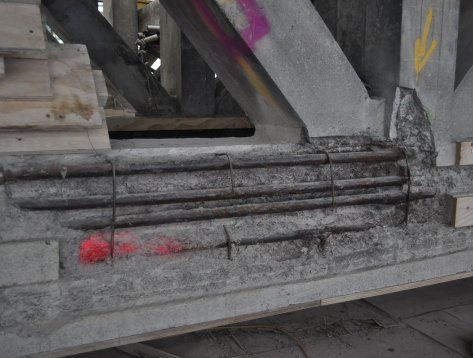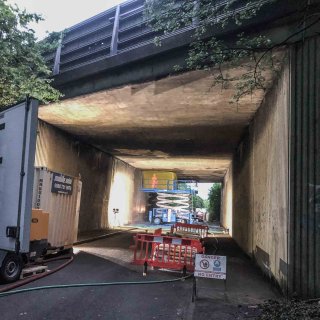Cleveland Bridge in the centre of Bath is one of the main routes connecting the M4 to the south coast. The bridge is now almost 200 years old and although it was originally built for pedestrians and horse-drawn carriages, it now carries roughly 17,000 vehicles a day, including coaches and heavy goods lorries weighing up to 44 tonnes. The bridge is Grade II-listed.
Cleveland Bridge was originally designed by architect Henry Goodridge to take the traffic of his day, namely horse-drawn vehicles and pedestrians, and was built in 1826 by William Hazledine. It was constructed using the warm golden Bath Stone from the area and consisted of one elegant cast-iron arched span. In 1928, to accommodate the increased weight of traffic with the introduction of mechanised vehicles, the bridge was reconstructed and upgraded to include four reinforced concrete trusses within the existing cast-iron arches.
In 1992, an investigation identified that the footways and the parapets could not take the then current levels of wheel and impact loads, and further upgrades were carried out by installing two steel portal frames under these concrete sections of the bridge.
In recent surveys carried out by Bath and North-East Somerset Council (the highway authority responsible for the maintenance of the bridge), it was identified that several structural components of the bridge needed to be maintained, repaired or replaced in order for it to continue to function safely. The defects were deemed so significant that the weight restriction was immediately lowered to 18 tonnes until the repairs and restoration works had been carried out. Although the refurbishment works were mainly to ensure the structural safety and integrity of the bridge, due to its listed status care had to be taken to also preserve the heritage value of this iconic structure.
The works consisted of the following;
-
- concrete repairs to the truss and deck slabs (the foundation of the flat top of the carriageway),
- installation of galvanic anodes (DAS and hybrid),
- Installation of carbon-fibre plates (CFRP),
- repairs to the hanging bars,
- repairs to the masonry abutments (stone supports),
- repairs to the cast-iron arches and parapets,
- removal of the existing coatings and repainting of the cast-iron arches,
- application of new deck waterproofing to prevent future weather damage, and
- installation of a protective coating system to all the exposed concrete elements.
Due to the extent of the concrete repairs, and to avoid overloading the structure while the works were being undertaken, a phased repair plan had to be implemented to coincide with lane closures on the bridge. CRL was appointed as the specialist concrete repair contractor by the principal contractor, Dyer & Butler. The work process started with a joint survey by WSP, Dyer & Butler and CRL to identify by how much the need for concrete repairs had increased since the previous survey in 2019. Hammer testing identified where the concrete had delaminated and once the areas requiring repair were identified and marked out, operatives were able to prepare the patches to BS EN 1504(1) and carry out the repairs.
The initial intention was to remove any delaminated, spalled, substandard or defective concrete using hydrodemolition. However, once it was realised that the size of the individual defects was dramatically larger than first envisioned, the allowable breakout size was reduced to maintain the structural stability of the bridge. To address the concerns about accidentally breaking out too much defective concrete, it was agreed that these areas should be broken out using hand-held breakers.
The concrete repair works carried out to date include: 551 repairs under the bridge totalling a volume of 10m3; the installation of 1.4km of DAS galvanic anodes and 2000 hybrid anodes; and the application of 1400m2 of protective anti-carbonation coating. From CRL’s perspective, even though the nature of the contract was typical of the works commonly undertaken – concrete repairs, continuity testing, installation of sacrificial anodes, reinstatement with a pre bagged flowable micro-concrete and application of protective coatings – the scale of the works and the number and type of anodes installed was exceptional. Access under the bridge was also extremely difficult to navigate, requiring all 37 tonnes of micro-concrete to be carried below the bridge and placed by hand.
The bridge was initially closed completely for 12 weeks to allow the deck repairs, installation of the hybrid galvanic anodes, deck waterproofing and resurfacing to take place on one side, before being reopened under a single lane closure to enable operatives to work safely on the closed side of the bridge.
The works were not without their issues, with the biggest change being the increase in the quantity and size of the concrete repairs required – from 4 to 10m3. As the amount of concrete that was needed to be broken out in individual patches increased by such a large amount, it became necessary to install a system of temporary propping to support the individual elements as they underwent repairs. Designs were needed for each set of temporary works and coupled with their installation, this increased the duration of the works significantly.
The next issue that wasn’t envisaged at tender stage was the need for electrical continuity between the reinforcement bars within the structure. For the galvanic and hybrid anodes to work as designed, all the reinforcement bars needed to be electrically connected to one another. This is normally the case if the bars are tied tightly together, but due to the level of corrosion on the bars there was no longer any electrical connection. To overcome this issue and make sure the cathodic protection system worked correctly to protect the whole structure, it became necessary to weld an additional 60m of 8mm bars between the existing uncorroded reinforcement to reintroduce electrical continuity before installing the galvanic anodes.

"A difficult project carried out in cramped and confined conditions, coupled with an every changing scope and pressure to get the road re-opened. In the end it all worked out and the bridge is now good to go for hopefully another 150 years ..."
Jonathan Bradshaw | Project Manager | CRL

































